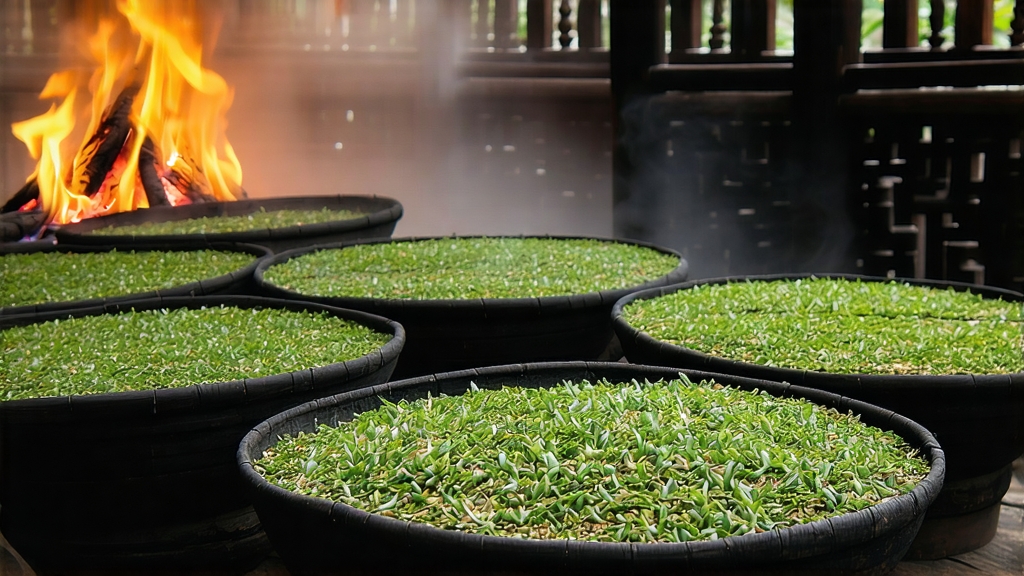
Few teas carry as much myth, aroma, and polarizing charisma as Lapsang Souchong, the original black tea of China. To the uninitiated, its fragrance can evoke campfire nostalgia or smoked bacon; to the connoisseur, it is a layered sonnet of resin, longan, and mountain mist. Born in the granite gorges of the Wuyi massif, this tea predates every other black tea on Earth, yet it remains stubbornly artisanal, still hand-finished over pinewood embers in villages where the dialect has changed little since the Ming dynasty.
History: From Ming Soldiers to European Courts
Legend dates the birth of Lapsang Souchong to 1567–1610, when a Qingming rainstorm forced tea farmers in Tongmu village to abandon withering leaves. To save the harvest, they rushed the leaf over open fires of fresh pine, inadvertently creating the first fully oxidized, smoked black tea. Dutch traders carried the novel “bohea” (from the Minnan “wuyi”) to Europe, where it filled the porcelain cups of Parisian salons and London coffeehouses. By the early 1600s Lapsang Souchong had become the prototype for all black tea; even the English word “bohea” once referred generically to black tea before “black” itself entered the lexicon.
Geography: One Canyon, Two Nations of Smoke
Authentic Lapsang Souchong comes only from the 600–1,200 m core zone of Tongmu Guan, a protected enclave inside Fujian’s Wuyishan National Park. Here, humid subtropical air collides with mineral-rich granite soils, feeding the small-leaf tea bushes (Camellia sinensis var. sinensis) that cling to narrow terraces. Cool nights slow growth, concentrating sugars and volatiles that later marry with pine smoke. Outside this 48 km² terroir, similar techniques yield “wai shan xiao zhong,” but only Tongmu leaf may legally bear the designation “Zhengshan Xiaozhong” (Original Mountain Small Leaf).
Varietals: Smoke, No Smoke, and Sweet Potato
- Traditional Songzhong (Pine-Smoked): The classic, dried over resinous Masson pine fires for 8–12 hours, absorbing guaiacol and syringol molecules that deliver the signature tarry sweetness.
- Unsmoked Xiaozhong: A modern response to export demand, withered and baked in electric ovens; cup profile of dried longan, honey, and subtle cocoa.
- Wild Zongzhong: Harvested from seed-propagated feral bushes above 1,000 m; narrower leaves, higher essential-oil content, and a cooling camphor finish.
- Jin Jun Mei: A 2005 offshoot using only buds, oxidized at lower temperatures and finished over charcoal rather than pine; notes of caramelized peach and malt.
Craft: Eight Steps Through Fire and Mist
- Plucking: One bud with two or three leaves, picked before Grain Rain, ideally between 9 a.m. and 3 p.m. when dew has evaporated.
- Indoor Withering: Leaves are laid on bamboo trays in the loft of the tea factory, where mountain breezes reduce moisture to 65 % within 4–6 hours.
- Rolling: A 45-minute gentle bruising on fir-wood tables breaks cell walls, initiating oxidation without the CTC (crush-tear-curl) violence used in commodity tea.
- Oxidation: The leaf pile is covered with wet cloths in a pine-wood box for 3–5 hours at 24 °C, turning coppery brown while developing malty theaflavins.
- Pan-Firing: Quick 200 °C wok roasting for 3 minutes halts oxidation, locking in color and aroma.
- Rolling & Shaping: A second, tighter roll twists leaves into the distinctive strip shape that allows slow smoke penetration.
- Pine-Smoke Drying: The critical signature. Fresh pinewood is lit in a pit below a multi-tiered bamboo rack; tea absorbs smoke in three 20-minute cycles, resting between each to prevent acrid over-smoking.
- Final Charcoal Bake: Gentle 70 °C bake over emberless charcoal for 2 hours refines texture and stabilizes moisture to 5 %.
Chemistry of Smoke: Why It